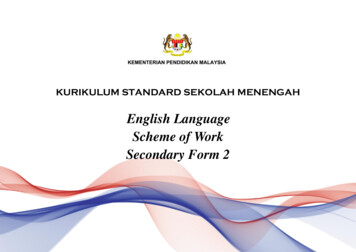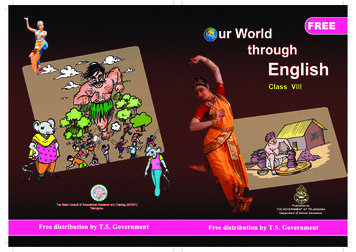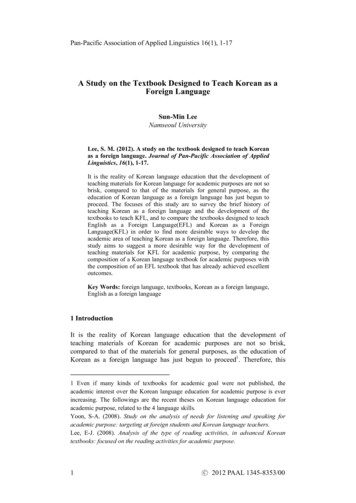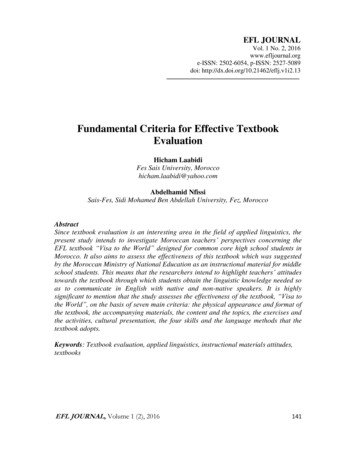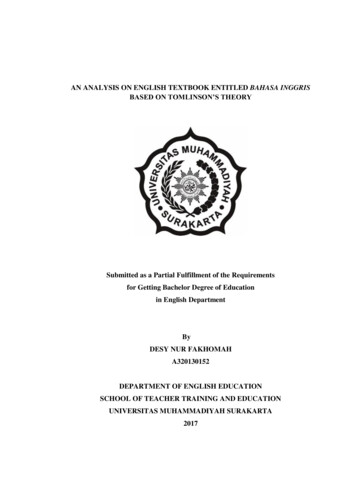
Transcription
AN ANALYSIS ON ENGLISH TEXTBOOK ENTITLED BAHASA INGGRISBASED ON TOMLINSON’S THEORYSubmitted as a Partial Fulfillment of the Requirementsfor Getting Bachelor Degree of Educationin English DepartmentByDESY NUR FAKHOMAHA320130152DEPARTMENT OF ENGLISH EDUCATIONSCHOOL OF TEACHER TRAINING AND EDUCATIONUNIVERSITAS MUHAMMADIYAH SURAKARTA2017
AN ANALYSIS ON ENGLISH TEXTBOOK ENTITLED BAHASA INGGRISBASED ON TOMLINSON’S THEORYAbstractThis research paper is aimed to investigate the compatibility of materials inthe textbook Bahasa Inggris based on Tomlinson’s theory. It also investigateswhether the materials in the textbook support students’ language skill or not inEnglish teaching learning process. The writer uses descriptive research as the type ofthe study. The data of the study are the content of English textbook entitled BahasaInggris. The analysis is done by using Three Level of Analysis by Littlejohn (2011).They are: 1) Level 1 Analysis: ‘What is There’ (Objective Description), 2) Level 2Analysis: ‘What is Required of Users’ (Subjective Analysis), and 3) Level 3Analysis: ‘What is Implied’ (Subjective Inference). The result of this study showsthat the English textbook Bahasa Inggris fulfills 15 criteria or 93,75% ofTomlinson’s theory and caters 3 language skills (speaking, reading and writing). Itmeans that the textbook is suitable to be used by the students.Keywords: textbook, Tomlinson’s theory, compatibility, language skillsAbstrakPenelitian ini bertujuan untuk mengetahui kesesuaian materi pada buku teksBahasa Inggris berdasarkan teori Tomlinson. Penelitian ini juga untuk mengetahuiapakah materi pada buku teks mendukung keterampilanbahasa siswa atau tidak padaproses pembelajaran Bahasa Inggris. Penulis menggunakan tipe penelitian deskriptif.Data penelitian ini adalah materi buku teks bahasa inggris berjudul Bahasa Inggris.Analisis ini dilakukan dengan menggunakan 3 level analisis oleh Littlejohn (2011).Tiga level analisis itu adalah: 1) Analisis Level 1: ‘What is There’ (DeskripsiObjektif), 2) Analisis Level 2: ‘What is Required of Users’ (Analisis Subjektif), dan3)Analisis Level 3: ‘What is Implied’ (Kesimpulan Subjektif). Hasil penelitian inimenunjukkan bahwa buku teks Bahasa Inggris memenuhi 15 kriteria or 93,75% dariteori Tomlinson dan memenuhi 3 keterampilan bahasa (berbicara, membaca danmenulis). Hal ini menunjukkan bahwa buku teks dapat digunakan oleh siswa.Kata Kunci: bukuteks, teori Tomlinson, kesesuaian, keterampilanbahasa1.INTRODUCTIONIn Indonesia, English becomes a foreign language. For many years, Englishhas been taught at high schools in Indonesia. In teaching and learning process ofEnglish. There are many aspects can affect the outcomes of students’ learning. These1
aspects can emerge from the pre-teaching, while teaching and post teachingprocesses. All of the process requires teachers to play an active role. The teachersshould design the syllabus, materials and teaching procedure in the classroom.Richards (2001: 1) argues that “teaching materials are key component in mostlanguage programs. Whether the teacher uses a textbook, institutional preparedmaterial or make use of his or her own materials, instructional materials generallyserve as the basis for much of the language input learners receive and the languagepractice that occurs in the classroom”. One of the materials in learning English istextbook.According to Cunningsworth (1984: 1), textbook is a book written byexperienced and well-qualified people and the material contained in them is usuallycarefully tested in pilot studies in actual teaching situations before publication.Textbook is used in the teaching learning process exactly in teaching English.Indonesia has been using textbook for many years in education.O’Neill (1982: 104) added the reasons for the use of textbooks: Firstly, mostparts of textbook materials are appropriate for students' needs, even if they are notespecially designed for them. Secondly, they make it possible for students to plan forfuture learning and also review the previous materials or lessons. Thirdly, textbooksprovide students with high quality materials at a reasonable price. Finally, suitabletextbooks allow teachers to adapt and modify them to meet the learners' needs andalso allow for natural interaction to happen.Actually, the teachers depend on the textbook. Textbook becomes animportant thing in the class for teaching and learning process. A textbook means acreated material designed as materials for teaching learning process in order toincrease the learners’ knowledge and experience. “Textbook are best seen as a sourcein achieving aims and objectives that have been set in terms of learner needs”(Cunningsworth, 1995: 7). Thus, textbook is one source of materials in teachinglearning process.Tomlinson (1998: 7-21) gives good criteria of textbook. They are 1)Materialsshould achieve impact, 2)Materials should help learners to feel at ease, 3)Materials2
should help learners to develop confidence, 4)What is being taught should beperceived by learners as relevant and useful, 5)Materials should require and facilitatelearner self-investment, 6)Learners must be ready to acquire the points being taught,7)Materials should expose the learners to language in authentic use, 8)The learners’attention should be drawn to linguistic features of the input, 9)Materials shouldprovide the learners with opportunities to use the target language to achievecommunicative purposes, 10)Materials should take into account that the positiveeffects of instruction are usually delayed, 11)Materials should take into account thatlearners differ in learning styles, 12)Materials should take into account that learnersdiffer in affective attitudes, 13)Materials should permit a silent period at thebeginning of instructions, 14)Materials should maximize learning potential byencouraging intellectual, aesthetic and emotional involvement which stimulates bothright and left brain activities, 15)Materials should not rely too much on controlledpractice, and 16)Materials should provide opportunities for outcome feedback.Selecting textbook is an important thing. A textbook should be suitable notonly with curriculum but also for the students. In Indonesia itself, textbook becomesa controversial thing in education. Nowadays, many cases are reported that textbookscontain unsuitable content or text for the students. The society, especially the parents,are worried about this problem. And also the teachers sometimes realize that thecontent is not suitable for the students when they are teaching in the class.Based on phenomena, the researcher wants to conduct a research of goodtextbook by using Tomlinson’s criteria of English textbook entitled “An Analysis ofEnglish Textbook Entitled ‘Bahasa Inggris’ Based on Tomlinson’s Theory”. Thisstudy is hoped to enrich standardized English textbooks and give better contributionof textbooks usage in teaching English, especially in Indonesia.The research questions in this study are: 1) are the materials in the textbookcompatible with Tomlinson’s criteria?, and 2) do the materials in the textbooksupport students’ language skill in English teaching learning process?. Therefore,this study is aimed to: 1) investigate the compatibility of materials in the textbook3
based on Tomlinson’s criteria, and 2)investigate whether the materials in thetextbook support students’ language skill or not in English teaching learning process.2.RESEARCH METHODThe type of the research which is conducted by the writer is descriptive research.The writer’s purpose is to describe whether the English textbook entitled BahasaInggris is compatible with Tomlinson’s theory or not.The object of this study is thematerials of English textbook entitled Bahasa Inggris which is used for X gradeSenior High School. It was published by Minister of Education and Culture in2014.The data of this study are the content of English textbook entitled BahasaInggris. They are in the form of pdf document. The writer collects the data throughfollowing procedures:1)looking for the textbook, 2) observing the materials in thetextbook, and 3) matching materials with Thomlinson’s theory.The writer conductscontent analysis. The analysis is done by using Three Level of Analysis by Littlejohn(2011). They are: 1) Level 1 Analysis: ‘What is There’ (Objective Description), 2)Level 2 Analysis: ‘What is Required of Users’ (Subjective Analysis), and 3) Level 3Analysis: ‘What is Implied’ (Subjective Inference)3.FINDING AND DISCUSSION3.1 Finding3.1.1 The compatibility of materials in the textbook Bahasa Inggriswith Tomlinson’s theory3.1.1.1 Materials should achieve impactImpact can be achieved if the materials are new, varied, presentedattractively, and appealing content. The newness in the textbook “BahasaInggris” is proved by 9 chapters which have different themes. The tittle ofthe chapters are: 1) Talking about Self, 2) Complimenting and ShowingCare, 3) Expressing Intention, 4) Congratulating Others, 5) DescribingPeople, 6) Visiting Ecotourism Destination, 7) Visiting Niagara Falls, 8)Describing Historical Places and 9) Giving Announcement. Those topics arerelated to social phenomena in Indonesia and science in the world such as in4
chapter Visiting Niagara Falls. Variety can be achieved from various typesof text and source of text and various of speaking activity. Various of text isproved on page 4, 5, 58, 70,78, 84, 95, 105, and 106. Various of speakingactivity is proved by 12-14, 25-27, 37-40, 50-51, 63, 79, 89, 101, and113.Attractiveness of the English textbook is achieved by the use ofpictures.Textbook Bahasa Inggris provides pictures which are related to thetopics.Attractiveness of the textbook is proved on page 13, 21, 22, 24, 2, 32,25, 56, 70, 78, 84, and 95. The following picture is one of example of thenewness in the textbook.The Newness of Materials in Bahasa Inggris3.1.1.2 Material should help learners to feel at easeMaterials can help students to feel at ease by providing dialogue andpicture, the texts and the illustrations, grammar and examples, and exerciseand blank spaces. Dialogue and picture are proved on page 13, 21, 22, 24,and 25. Texts and illustration are proved on page 70, 78, 84, and 95.Grammar and examples are proved on page 11, 61, 62, 73, 74, 88, 100, and111. Therefore, the textbook fulfills this criterion as following picture.5
Dialogue and picture on page 133.1.1.3 Material should help learners to develop confidenceMany students feel confident if they think that the materials theylearn are not too difficult(Harsono, 2007). In Bahasa Inggris, there aremany easy task and activities. In addition, the tasks and activities shouldstimulate students. The textbook uses simple language to accomplish everytask. Therefore, Bahasa Inggris fulfills this criterion.1) Stimulating taskThe textbook provides tasks which stimulate students’ confidence.Stimulating tasks in the textbook are proved on page 25, 26, 52, and 53.It is the example of stimulating task:Stimulating task on page 256
2) Using simple language to accomplish every taskThe textbook use simple language in the vocabulary andpronunciation task. Simple language are proved in the textbook on page2, 3, 18, 19,32, 44, 45, 57, 58, 69, 83, 95, and 104. It is the example ofsimple language.Simple language on page 23.1.1.4 What is being taught should be perceived by learners as relevant anduseful.The materials are relevant and useful for the students’ carrier andlife. Textbook Bahasa Inggris provides materials which are related to thetopics. Chapter 1 Talking about Self is useful for the students to introducethemselves to others. In addition, it is also relevant because the students aretenth grade who need to introduce and know their friends. Chapter 2,3, and4 make the students can communicate and show their expressions to otherpeople. So, these chapters are very useful for the students. Chapter 5, 6, 7,and 8 make the students can describe people and places. These chapters arevery useful and relevant for students to describe their family or friends andplaces to other people. Chapter 9 Giving Announcement makes the studentscan make announcement writtenly. It is very relevant for the studentsbecause some of them join organization which should make anannouncement. Therefore, all chapters in Bahasa Inggris are relevant anduseful for the students in real life.7
3.1.1.5 Materials should require and facilitate learner self-investment.It can be achieved by providing students with choices of focus andactivity, giving students topic control, and engaging students in learnercentered discovery activities. Bahasa Inggrisprovides many activities andfocus in each chapter. There are nine chapters in the textbook. Thetextboook also provides controlled practice in each chapter. In addition, thetextbook also uses scientific approach in the textbook for teaching andlearning. Therefore, the textbook fulfills this criterion.3.1.1.6 Learners must be ready to acquire the points being taught.The materials create students’ readiness by providing focus attentionto language features or grammar. The textbook Bahasa Inggris providessub-chapter entitled Grammar Review. There are some chapters whichprovide Grammar Review.Grammar review is used for gaining students’knowledge especially grammar. It is grammar review in the textbook:Grammar Review on page 113.1.1.7 Materials should expose the learners to language in authentic use.The textbook Bahasa Inggris only provides a text which is from theauthentic source. The text is on page 95 which entitled The Secrets ofStonehenge. It is taken from Reading Explorer 3 by Nancy Douglas in 2010.8
3.1.1.8 The learners’ attention should be drawn to linguistic features of theinput.The textbook Bahasa Inggris provides some chapters which havesub-chapter Grammar Review. This sub-chapter is evidence that thetextbook provides learners’ attention to linguistic features of the input.3.1.1.9 Materials should provide the learners with opportunities to use thetarget language to achieve communicative purposes.The communicative interaction can be in the form of post-reading,creative writing and creative speaking activities. The textbook BahasaInggris provides chapters which cater those communicative interactions.They are: a) Chapter 1 provides reading, speaking and writing activities, b)Chapter 2 provides speaking and writing activities, c) Chapter 3 providesspeaking and writing activities, d) Chapter 4 provides reading, speaking andwriting activities, e) Chapter 5 provides reading, speaking and writingactivities, f) Chapter 6 provides reading, speaking and writing activities, g)Chapter 7 provides reading, speaking and writing activities, h) Chapter 8provides reading, speaking and writing activities, and i) Chapter 9 providesreading, speaking and writing activities.3.1.1.10 Materials should take into account that the positive effects ofinstruction are usually delayed.Learning language is a gradual process. To facilitate the gradualprocess, it is important to give frequent exposure to the instructed languagefeatures in communicative use. The textbook Bahasa Inggris provides thegradual process to learn language. It can be looked from sub-chapterspeaking. Sub-chapter speaking in chapter I is very easy. It is about selfintroduction. Then, sub-chapter speaking in chapter II is about givingresponse. It is easy material. Sub-chapter speaking in chapter III and IV areabout short dialogues. They are rather difficult than the first and secondchapters. Sub-chapter speaking in chapter V, VI, and VII are about9
describing things. They are more difficult than the previous chapters. Subchapter speaking in chapter 8 is about dialogue in real life with parents andrelatives. It is more difficult than before. The last is about inviting someone.It is the most difficult. Therefore, the textbook Bahasa Inggris fulfills thiscriterion.3.1.1.11 Materials should take into account that learners differ in learningstyles.There are many learning styles. They are visual, c,global,dependentandindependent. The textbook provides some materials which cope withvarious learning styles. For visual learners, the textbook provides manytexts and picture. For auditory learners, the textbook provides sub-chapterpronunciation which the teacher should speak before the students repeat it.For kinaethetic learners, the textbook provides games activity in some subchapter warmer and one sub-chapter speaking. For studial learners, thetextbook provides exercises for language features in sub-chapter grammarreview.3.1.1.12 Materials should take into account that learners differ in affectiveattitudes.Affective attitude is dealt with feelings or emotions. The textbookprovides of activities and different types of activities to motivate students tolearn.3.1.1.13 Materials should permit a silent period at the beginning ofinstructions.The silent period is used to facilitate the development of an effectiveinternalized grammar and other language elements. It can help students toachieve proficiency. In addition, silent period is to introduce new languagepoints through activities which initially require comprehension beforeproduction. The textbook provides sub-chapter Vocabulary Builder in each10
chapter. It makes students gain new knowledge of vocabulary. It shows thatthe textbook help students to achieve proficiency. Furthermore, the textbookalso provides sub-chapter reading in some chapters before sub-chapterspeaking and wiriting. It shows that textbook Bahasa Inggris providescomprehension skill first before production skill. Therefore, textbookBahasa Inggris fulfills this criterion.3.1.1.14 Materials should maximize learning potential which stimulates bothright and left brain activities.Right and left brain have their own functions in human life. Right brainis fuctioned as spatial ability such as music, creativity, art, and shape.Meanwhile, left brain is functioned as logic thinking, language andmathematics. The textbook Bahasa Inggris provides a lot of activities whichstimulates left brain. The activities which stimulate left brain are vocabularybuilder, pronunciation practice, and grammar review. In the other side,textbook Bahasa Inggris does not provide activity which stimulate rightbrain. Therefore, the textbook does not fulfill this criterion.3.1.1.15 Materials should not rely too much on controlled practice.Controlled practice is a stage in a lesson where learner practices newlanguage in a limited form. Meanwhile, free practice means that learnerproduces language using the target content freely. Controlled activitiesallow students to solely focus on the new structure. Textbook BahasaInggris only provides one sub-chapter which is included in controlledpractice. That is Vocabulary Builder. Although it is provided in everychapter, it is only a kind of controlled practice from nine or ten subchapters. Sub-chapter Vocabulary Builderare on page 2, 18, 33, 44, 56, 69,82-83, 94, and 104. Therefore, textbook Bahasa Inggris fulfills thiscriterion.11
3.1.1.16 Materials should provide for outcome feedback.The textbook provides opportunities for outcome feedback by providingsub-chapter reflection in each chapter. Reflection is used for whether thelearners understand or not with the materials which are learnt. Reflection inBahasa Inggris are on page 15, 30, 41, 54, 65-66, 80, 92, 102, and 114.Therefore, the textbook fulfills this criterion.Reflection on page 153.1.2 Language skills in the materials of the textbookIn learning English, it has two general skills. They are receptive andproductive skills. Receptive skills consist of listening and reading skills.Productive skills consist of speaking and writing skills. Both receiptive andproductive skills are corresponded. Listening corresponds to speaking andreading corresponds to writing.The textbook Bahasa Inggris only provides three skills from fourlanguage skills. They are reading, speaking and writing. The textbookprovides each sub-chapter for one skill. They are sub-chapter reading, subchapter speaking and sub chapter writing. All of them are provided in eachchapter in the textbook. Therefore, the textbook Bahasa Inggris fulfills threelanguage skills (reading, speaking and writing). And the textbook does notprovide listening skill for the students.12
3.1.3 Matching3.1.3.1 The compatibility the materials in the textbook with Tomlinson’stheory.Total NumberThe number of criteria: 16Total of criteria fulfilled by the textbook : 15Percentage:Total of criteria fulfilled by the textbook x 100%The number of criteria 15x 100 93,75%163.1.3.12 The matching of the materials of the textbook with languageskills.Total NumberThe number of skills:4Total of skills in the textbook:3Percentage:Total of skills in the textbookx 100%The number of skills 3x 100 75%43.2 Discussion3.2.1 The compatibility of the materials in the textbook withTomlinson’s theoryThe textbook Bahasa Inggris fulfills fifteen criteria from sixteencriteria. The criteria which are fulfilled are: 1) Materials should achieve13
impact, 2) Materials should help learners to feel at ease, 3) Materials shouldhelp learners to develop confidence, 4) What is being taught should beperceived by learners as relevant and useful, 5) Materials should require andfacilitate learner self-investment, 6) Learners must be ready to acquire thepoints being taught, 7) Materials should expose the learners to language inauthentic use, 8) The learners’ attention should be drawn to linguisticfeatures of the input, 9) Materials should provide the learners withopportunities to use the target language to achieve communicative purposes,10) Materials should take into account that the positive effects of instructionare usually delayed, 11) Materials should take into account that learnersdiffer in learning styles, 12) Materials should take into account that learnersdiffer in affective attitudes, 13) Materials should permit a silent period at thebeginning of instructions, 14) Materials should not rely too much oncontrolled practice, and 15) Materials should provide opportunities foroutcome feedback. Meanwhile, the textbook does not fulfill one criterion.Therefore, the percentage of the compatibility materials in thetextbook with Tomlinson’s theory is 93,75%. It can be concluded thatBahasa Inggris is a textbook which is suitable to used by tenth gradestudents of senior high school.3.2.2 Language skills which are catered in the textbookThe textbook only caters three language skills. They are reading,speaking and writing. The percentage shows 75% of language which arecatered by textbook Bahasa Inggris. Therefore, the textbook supports threelanguage skills for the students in English teaching learning process.However, the textbook does not support one skill. It is listening skill.Therefore, the textbook is suitable to be used by the students. In the otherside, the students cannot get listening skill from the textbook.14
4.CONCLUSIONBased on research finding and discussion, the writer concludes that BahasaInggris is compatible with Tomlinson’s criteria of good textbook. The textbook gainspercentage 93,75% of the compatible with Tomlinson’s theory. The textbook alsosupports three language skills for learning. They are reading, speaking and writing. Itgains percentage 75%. Therefore, the textbook is suitable to be used by tenth gradestudents.REFERENCESChandran, Shanti. 2003. “Where are the ELT Textbook?””, in Willy A. Renandya(Ed.), Methodology and Materials Design in Language Teaching: CurrentPerception and Practices and their Implications. Singapore : SEAMEORegional language centre.Cunningsworth, Alan. 1984. Evaluating and Selecting EFL Teaching materials.Great Britain: Biddles Ltd.Cunningsworth. 1995. Choosing your Coursebook. New York: Macmillan.Harmer, J. 2007. The Changing World of English. In the Practice of EnglishLanguage Teaching. UK: Cambridge.Harsono, Y. M. (2007, August). Developing Learning Materials For SpecificPurposes. TEFLIN Journal, hal. 169-179.Hutchinson, T. and A. Waters. 1994. The Textbook as Agent of Change. ELTJournal.O’Neill, Robert. 1982. Why Use Textbooks?. ELT Journal 36/2.Richards, Jack C. 1985. Language Curriculum Development. University of HawaiiWorking Papers in English as a Second Language, 4/1.Richards, Jack C. 2001. Curriculum Development in Language Teaching.Cambridge: Cambridge University Press.Tomlinson, Brian. 1998. Material Development in Language Teaching. Cambridge:Cambridge University Press.Tomlinson, Brian (2011). Material development in Language Teaching (2ndEd.).Cambridge: Cambridge University Press.15
AN ANALYSIS ON ENGLISH TEXTBOOK ENTITLED BAHASA INGGRIS BASED ON TOMLINSON'S THEORY Submitted as a Partial Fulfillment of the Requirements for Getting Bachelor Degree of Education in English Department By DESY NUR FAKHOMAH A320130152 DEPARTMENT OF ENGLISH EDUCATION SCHOOL OF TEACHER TRAINING AND EDUCATION UNIVERSITAS MUHAMMADIYAH SURAKARTA 2017




